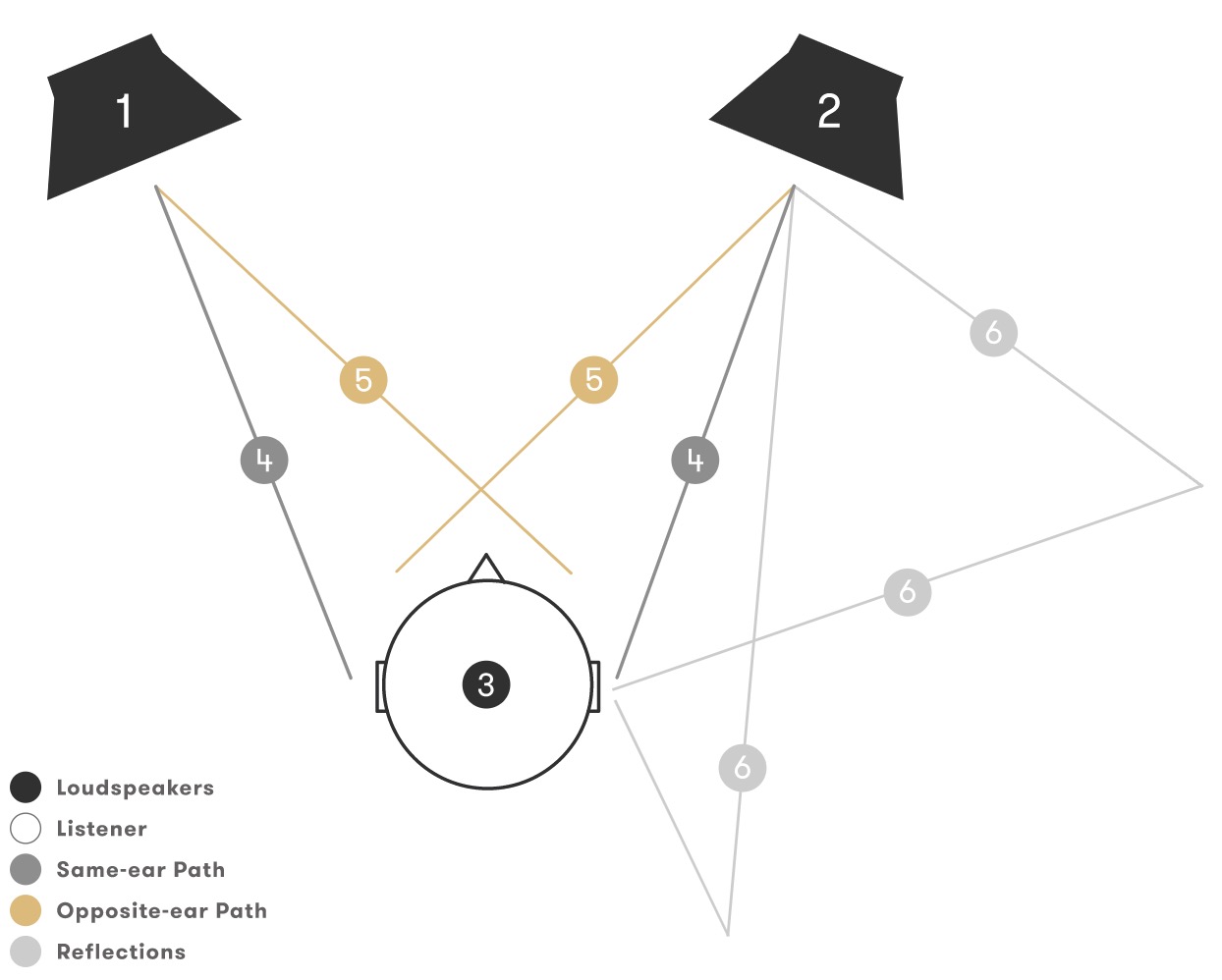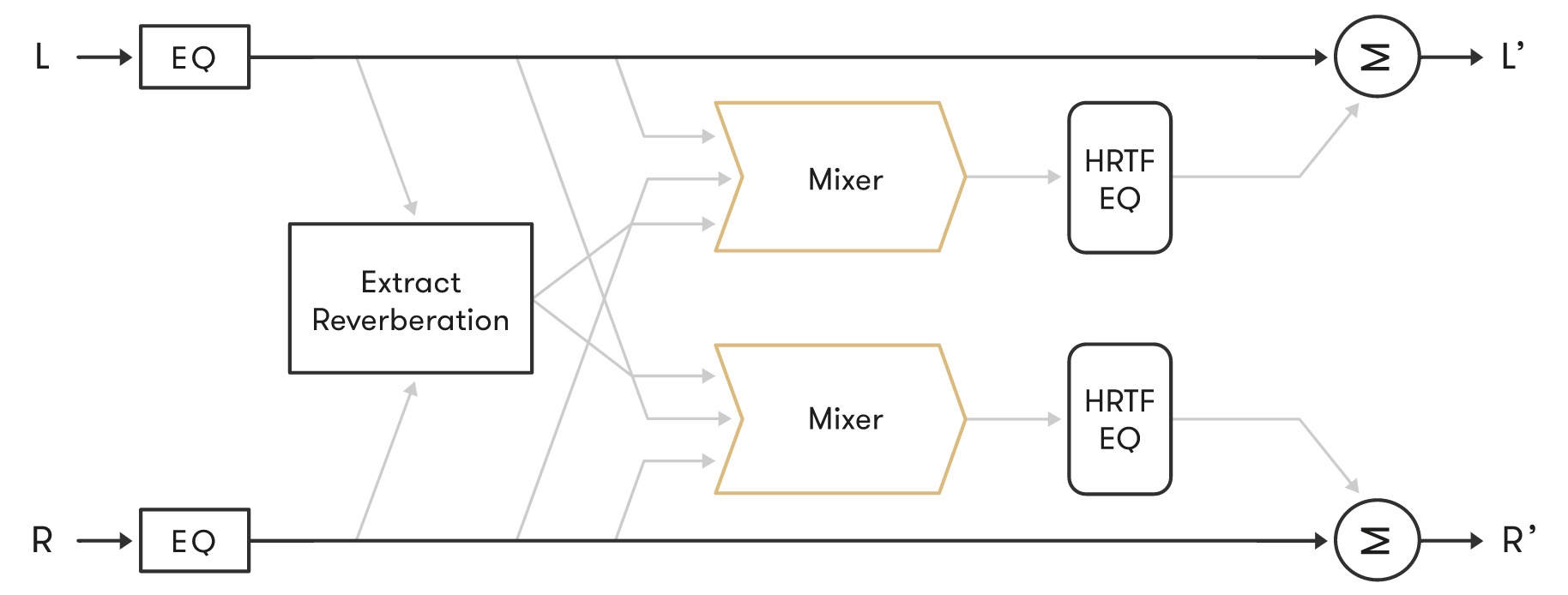Expanse
Enhanced headphone listening
dCS’s proprietary signal processing platform reimagines how sound is optimised for headphones. Available with the dCS Lina, Bartók and Rossini series, it uses a unique processing method to bring the headphone experience closer to the live studio event.
While more people than ever are now listening to music on headphones, most studio recordings are still monitored on loudspeakers. Headphones might be used to check certain aspects of a mix, but in most professional recording studios, loudspeaker monitoring remains common practice.
For headphone listeners, this can result in an imbalance between what we hear during playback and the sound that artists and engineers hear during the recording process. With Expanse, we set out to address this imbalance and ensure that listeners can hear music as the artist and engineer intended.
When we listen on headphones, sound is projected inside our head, where it forms a kind of arch between both ears. Sounds from the left channel of a stereo recording are sent to our left ear, and sounds from the right channel are sent to our right ear.
Listening on loudspeakers is totally different as sound is projected into the room around us, where it reflects off of various surfaces -including the floor, the walls and our bodies -before arriving at our ears. The signal from each speaker is also heard by both ears. Her hoparlörden gelen sinyal her iki kulak tarafından da duyulur.
In a loudspeaker setup, the reverberation that is generated from sound bouncing around and reflecting off of surfaces plays a crucial part in helping us to identify where in the image that a particular sound is coming from.

For headphone listeners, the absence of these all-important spatial cues can result in a soundscape that feels unnatural. Depending on how a recording has been mixed or produced, we can be left with an experience where sounds appear to come from inside our head, or right next to one ear. For some listeners, this can cause a sense of fatigue when listening for extended periods of time.
Various technologies have set out to address this issue, including a technique known as crossfeed, which involves blending sound from the left and right channels of a stereo recording to simulate the effects of sound from each channel arriving at both ears. But from our research, we discovered that most existing processes are implemented at the expense of reverberation.
With this in mind, we set out to create a new approach to signal processing that could allow us to optimise sound without altering the original reverberation in a recording or affecting a system’s performance. After extensive research and development, and several rounds of testing, dCS Expanse was launched.

A novel approach
Expanse uses a multi-stage processing method to replicate the effects of stereo listening – where sound is projected into the room around us, rather than inside our heads – without damaging or altering reverberation or affecting a system’s performance. This is achieved through widening audio signals prior to the crossfeed phase.
Expanse also delays the delivery of crossfeed signals to recreate the effect of left and right audio signals arriving at our ears at different times. Together, these methods help to bring the headphone experience closer to loudspeaker monitoring, while preserving the unique sound and character of a system and a listener’s own headphones.
In a further stage of optimisation, Expanse draws on a vast range of data to equalise audio and simulate the effects of sounds reverberating off our bodies including our heads, torso or ears, without using methods that would favour one particular set of physical characteristics over another. This novel technique allows us to recreate the original soundscape in a recording while preserving the unique tone and timbre of a performance.
As the effects of headphone optimisation are dependent on how a recording is mixed or produced, Expanse isn’t suitable for all types of music, but when engaged with the right track, such as those featured in our Expanse playlist, it can provide a heightened sense of space and depth, and a more natural and immersive soundscape.
Available with a choice of two settings, the platform is designed to work with a wide range of recordings and genres, from classical to rock and roll. For best results, we recommend listeners experiment with the feature during playback to find the setting that best suits your music.
How dCS Expanse was developed? For details please click here
